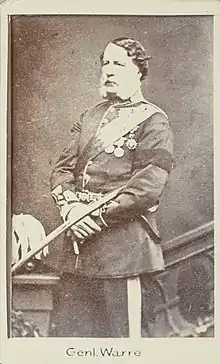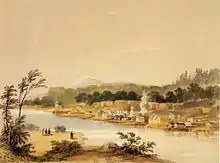Sir Henry Warre | |
|---|---|
 General Warre about 1860 | |
| Birth name | Henry James Warre |
| Born | 12 January 1819[1] Cape Town, Cape Colony |
| Died | 3 April 1898 (aged 79) London, England |
| Allegiance | |
| Service/ | |
| Years of service | 1837–1881 |
| Rank | Lieutenant-General |
| Commands held | Bombay Army |
| Battles/wars | Crimean War Second Taranaki War Second Anglo-Afghan War |
| Awards | Knight Commander of the Order of the Bath |
Lieutenant-General Sir Henry James Warre KCB (12 January 1819 – 3 April 1898) was a British Army officer.
Early life
Warre was born in Cape Town, Cape Colony, the son of Lieutenant-General Sir William Warre (1784–1853) and Selina Anna Maling, the youngest daughter of Christopher Thompson Maling.[1] His father saw service in the Peninsular War as aide-de-camp to William Beresford, 1st Viscount Beresford.[2] His mother's elder sister Sophia married Henry Phipps, 1st Earl of Mulgrave, and was the mother of Constantine Phipps, 1st Marquess of Normanby.[3]
He was baptised on his first birthday at St Nicholas Church, Brighton, Sussex.[4]
Military career
Educated at the Royal Military College, Sandhurst, Warre was commissioned into the 54th Regiment of Foot in 1837.[5] He became aide-de-camp to Sir Richard Downes Jackson, Commander-in-Chief of the Forces in British North America in 1839.[5]

In 1845 he was sent on a military reconnaissance mission with Mervin Vavasour to the Oregon Country to prepare for a potential Anglo-American war over the territory.[5] During the trip he made paintings and sketches of the region, and reported on possible military preparations.[6]
Warre commanded the 57th Regiment of Foot in the Crimean War in 1855.[5] Later he led his regiment in the Second Taranaki War in New Zealand in Spring 1865, seizing Māori land on the north Taranaki coast and establishing posts from Pukearuhe, 50 km north of New Plymouth, to Ōpunake, 80 km south of the town.[7] He became Commander-in-Chief of the Bombay Army in 1878 and served in that role during the Second Anglo-Afghan War[8] until he retired in 1881.[9]
Warre was also a talented artist and published two books of sketches from his journeys: Sketches in North America and the Oregon Territory (1848)[10] and Sketches in the Crimea (1856).[11]
References
- 1 2 Burke's Genealogical and Heraldic History of Peerage, Baronetage and Knightage. Burke's Peerage Limited. 1898. p. 1702.
- ↑ Vetch, Robert Hamilton (1899). . In Lee, Sidney (ed.). Dictionary of National Biography. Vol. 59. London: Smith, Elder & Co.
- ↑ Mosley, Charles, ed. (2003). Burke's Peerage, Baronetage & Knighthood (107 ed.). Burke's Peerage & Gentry. p. 2920. ISBN 0-9711966-2-1.
- ↑ England, Select Births and Christenings, 1538–1975
- 1 2 3 4 Warre, Henry James
- ↑ Joseph Schafer, "Documents Relative to Warre and Vavasour’s Military Reconnoissance in Oregon, 1845-6", Quarterly of the Oregon Historical Society, Vol. 10, No. 1 (March, 1909), pp. 1-99.
- ↑ James Cowan, The New Zealand Wars: A History of the Maori Campaigns and the Pioneering Period: Vol II, Chapter 5, 1922
- ↑ National Archives
- ↑ Great Britain. India Office (1819). The India List and India Office List. Harrison. p. 123.
- ↑ Warre, Sir Henry (1848). Sketches in North America and the Oregon Territory. Dickinson & Company. ISBN 9780665172458.
Sketches in North America and the Oregon Territory warre.
- ↑ Warre, Sir Henry (1856). Sketches in the Crimea. Oxford University.
External links
![]() Media related to Henry James Warre at Wikimedia Commons
Media related to Henry James Warre at Wikimedia Commons
- Works by Henry Warre at Faded Page (Canada)